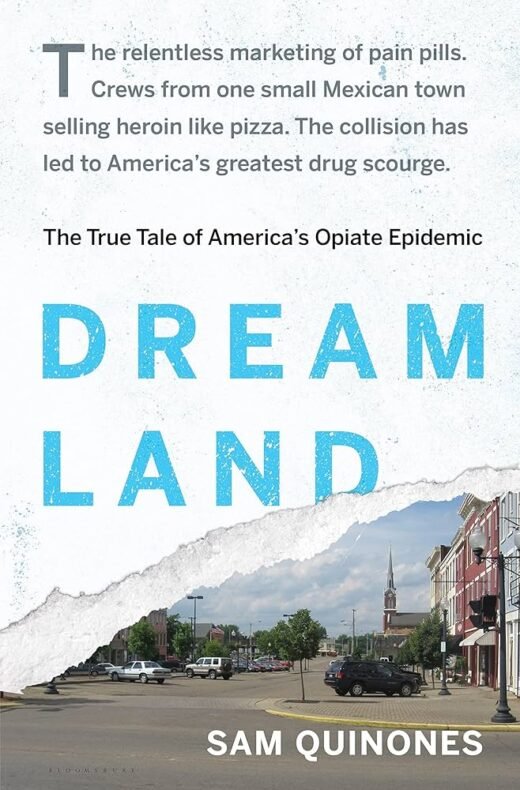For English review, please scroll down.
המחבר סם קווינונס (או משהו כזה תסלחו לי אם עיוותתי את השם) יוצא במסע מחקרי אל לב המאפליה של ההתמכרות האמריקאים להירואין ואופיאטים. במסע מבוסס על ראיונות עם מכורים, בני משפחתם, אנשי חוק וסוחרים קטנים הוא מתחכה אחר מקורות המגפה שתקפה את אמריקה בשני העשורים האחרונים.
הספר די מזעזע והוא מתאר שלב אחרי שלב את התפשטות מגפת ההתמכרות לאוקסיקונדין שהיא תרופת שיכוך לכאבים מקבוצת האופיאטים ולהתפשטות מגפת ההירואין בארה"ב. החל מהשלב החרדתי של מערכת הבריאות שהיתה מוטרדת מהתמכרות לתרופה ועד שחרור כל הבלמים בדהירה אל קטסטרופה לאומית וכלכלית.
מזעזע בשל הבורות המופגנת והבוטה של הממסד הרפואי לגבי השפעות הממכרות של התרופה. מזעזע בשל המניפולציות השיווקיות של חברות התרופות. ומזעזע בשל הנזק העצום והבלתי נתפס למליוני אנשים שפשוט חיפשו מזור לכאבים הכרוניים מהם סובלים ומצאו עצמם מכורים לתרופות.
הבעיה המטרידה ביותר היא הנורמטיביות לכאורה של האוקסיקונטין כתרופה לגיטימית שמתקבלת במרשם רופא אבל למעשה היא דומה בפעילות שלה להירואין. התעשיה של תרופות המרשם של אופיאטים גילגלה ואני מניחה שעדין מגלגלת מילארדים בזכות אמירות חסרות אחריות וטענות מופרכות שהתייחסו לכאב כסממן החמישי למדדי בריאות הגוף ולפסקה במאמר משנות ה 80 בו נטען כביכול שרק 1% מהמשתמשים יתמכרו לתרופה. טענה מופרכת והזויה שהוצאה מפיסקה שבעצמה הוצאה מההקשר הרחב שלה שהתייחס לאפשרות התמכרות בטיפול מבוקר ובהשגחה צמודה.
עשור לאחר המצאת האוקסיקונדין, והחדרתו לשוק באמצעים שיווקיים אגרסיביים כגון חופשות, מתנות קטנות וימי השתלמות ממומנים לרופאים, 6.1 מליון אמריקאים השתמשו לרעה בתרופה בין אם ע"י צריכה שלה ישירות והתמכרות לכדור ובין אם עי פירוקה ושימוש בחומר שבה בצורות לא מושהות. גם מתדון, שנחשב בטוח לשימוש הפך לגורם משפיע בחילחול התופעה, הוא לא טיפל בכאבים הכרוניים. יותר ויותר אמריקאים מתו משימוש במנת יתר של תרופות אופיטיות וגיל השימוש היה בירידה תלולה.
הספר עוסק בתחלואי מערכת הרווחה והבריאות האמריקאית כאשר מערכת הרווחה סיפקה ביטוח רפואי שאפשר קבלת כדורי אוקסיקונדין בעלות מגוחכת. סביב כדורים אלה התפתחה תעשיית סחר חליפין שאיפשרה לנתמכי רווחה להשיג מוצרי צריכה ונוחות בתמורה לכדורים. תעשית סחר החליפין בדרך עקיפה עודדה גניבות בסדר גודל קולוסאלי מוולמארט שהחזיקו את כלל מוצרי הצריכה והרווחה והמוכרנים שלהם לא היו לויאלים לחנות בגלל השכר הנמוך ואיפשרו את הגניבות הללו. הסופר נותן את הדוגמא של השפעת ההתמכרות ההמונית הזו על הכלכלה של פורט'סמית. ילדים מתו משימוש יתר ותושבי העיר המתועשת הלכו והתדרדרו ממעמד הביניים הכלכלי לאשפתות. מזעזע כבר כתבתי?
בד בבד מקבל הקורא סקירה על התפשטות מגיפת ההרואין ממקסיקו ודרכי החילחול שלו לתוך אוכלוסיות נורמטיביות גם בעקבות התפשטות מגפת האופיאטים כסם משלים. מגפה שלא זוהתה נכון בגלל מודל ההפעלה היחידני והבלתי אלים שלה. ההרואין שהיה נדבך משלים לכדורים חילחל בכמויות עצומות ומחירו בשוק ירד לסכומים מגוחכים. רשויות החוק לא הצליחו לשים ידם על מחוללי הפשיעה כי הסחר נעשה עי יחידנים שלא נשאו עימם כמויות סם משמעותיות. כך רק מבצע פדרלי חוצה מדינות הצליח לטרפד את מחוללי העבירה אבל הדבר היה מאוחר מידי ומעט מידי. לאחר אמצע שנות ה 2000 כאשר נוסחת האוקסיקונדין עברה שינוי עי חברת פרדו ולא היה ניתן לפרק את הכדור ולהשתמש בו בצורות לא מושהות, מגיפת ההירואין קיבלה מימדים מפחידים. ספורטאים, שחקנים ואנשי שם מהשורה מתו כתוצאה משימוש יתר גם אחרי שעברו גמילה. בעקבות מכת המוות של אנשים מפורסמים המודעות של האמריקאים התעוררה והחלה תנועת התנגדות כולל של מינהל התרופות, סידרת תביעות משפטיות כנגד החברות, פעולות אגרסיביות כנגד היחידנים שפעלו למכירת הירואין ומודעות גוברת של הרופאים לתוצאות ההרסניות של השימוש באופיטים.
מדובר באחד הספרים המרתקים שיצא לי לקרוא. עריכה קצת יותר הדוקה היתה מצמצת את החזרות בספר ומביאה יותר סיפורים אישיים. ארץ החלומות בפורת'סמית אוהיו, הפכה ברבות השנים לארץ חרבה כתוצאה מהתעלמות הרשויות האמריקאיות ונצלנות חברות התרופות לגריפת עושר אגדי. כיום, מה שנותר הוא ללמוד את הלקחים ולשקם את ההריסות של חיי מליונים שנחרבו.
לגבי המגפה של האופיטים אפשר לקרוא בכלכליסט מאמר מרתק שיצא בעקבות ספר אחר על התופעה – קליק
Dreamland: The True Tale of America's Opiate Epidemic/ Sam Quinones
Kindle Edition, 2015, 383 PP
דירוג SIVI –
איכות אודיו –

Author Sam Quinones embarks on a research journey to delve into the core of America's heroin and opiate addiction discrimination. Through a series of interviews with addicts, their families, law enforcement, and small-time traders, he seeks to uncover the origins of the epidemic that has ravaged America over the past two decades.
The book is quite shocking, detailing the step-by-step spread of the addiction epidemic to OxyContin, an opiate painkiller, as well as the heroin epidemic in the USA. It starts with the anxious phase of the healthcare system, troubled by drug addiction, and progresses to complete deregulation in the race toward a national and economic catastrophe.
It is shocking due to the blatant ignorance of the medical establishment regarding the addictive effects of the drugs. Shocking due to the marketing manipulations by pharmaceutical companies. And shocking due to the enormous and unimaginable harm to millions of people who were seeking relief for their chronic pain but found themselves addicted to drugs.
The most troubling issue is the perceived normativity of OxyContin as a legitimate prescription drug, even though its effects are similar to heroin. The opiate prescription drug industry has, presumably, made billions due to irresponsible declarations and unsubstantiated claims referring to pain as the fifth vital sign and from a paragraph in a 1980s article asserting that only 1% of users would become addicted. This unfounded and ludicrous claim was taken from a paragraph that, in turn, was taken out of context; it referred to the potential for addiction in controlled, closely supervised treatment.
A decade after the creation of OxyContin and its market introduction through aggressive marketing tactics such as vacations, small gifts, and sponsored training days for doctors, 6.1 million Americans were abusing the drug. They were either consuming it directly, becoming addicted to the pill, or breaking it down for use in unapproved forms. Even methadone, considered safe, became a factor in the phenomenon's spread, failing to treat chronic pain. The number of Americans dying from opiate overdoses was rising, with the age of users in sharp decline.
The book addresses the failures of the American welfare and healthcare systems, with the welfare program providing medical insurance that enabled obtaining OxyContin pills at negligible costs. A barter industry around these pills emerged, allowing welfare recipients to acquire consumer goods and comfort in exchange for pills. This bartering inadvertently fostered massive thefts from Walmart, which stocked all the consumer and welfare products; their salespeople, due to low wages, facilitated these thefts. The author illustrates the economic impact of mass addiction on the city of Portsmouth, where children died from overdoses, and the residents of this industrial city went from middle-class to poor. Was I already clear in saying shocking?
Simultaneously, the book provides an overview of the heroin epidemic's spreading from Mexico and its infiltration into conventional populations following the opiate epidemic, serving as a complementary drug. This plague was initially misdiagnosed due to its unique, non-violent operation. Vast amounts of heroin flooded the market, drastically reducing its price. Law enforcement struggled to apprehend the perpetrators because the trade was carried out by individuals carrying insignificant drug quantities. Only a cross-state federal operation managed to make headway against these criminals, but by then, it was too late and too little. After the mid-2000s, when the Purdue company altered the OxyContin formula, making it impossible to disintegrate the pill for unapproved uses, the heroin epidemic reached alarming proportions. Athletes, actors, and ordinary people have died from overdoses, even after detoxification. Following the deaths of notable individuals, American awareness was raised, leading to a widespread drug administration resistance movement, organized lawsuits against pharmaceutical companies, aggressive measures against those dealing heroin, and growing doctor awareness of the catastrophic effects of opiate use.
This is one of the most fascinating books I've ever read. Tighter editing could have reduced repetitions and introduced more personal stories. Over the years, Portsmouth, Ohio, turned into a wasteland due to the neglect of American authorities and pharmaceutical companies' exploitation to acquire legendary wealth. What remains is to learn the lessons and rebuild the lives of millions destroyed.
לגלות עוד מהאתר Sivi's Books
Subscribe to get the latest posts sent to your email.

